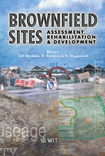Modeling Transport And Biodegradation Of PCE In Sandy Soil
Price
Free (open access)
Transaction
Volume
55
Pages
Published
2002
Size
434 kb
Paper DOI
10.2495/BF020511
Copyright
WIT Press
Author(s)
T. Sato, Y. Kimura & K. Takamizawa
Abstract
Transport of microorganism activating tetrachloroethylene (PCE) dechlorination was well described by mobile-immobile two-region model from laboratory column tests. Biological reaction was identified as first-order kinetics from batch tests where the bacterium strain was mixed with halogenated aliphatic compounds of PCE or TCE (trichloroethylene) as initial pollutant. PCE dechlororenation to dichloroethylene (DCE) via TCE was mathematically expressed as Michaelis-Menten equation while microbial growth rate did not show good performance due to Monod function. 1 Introduction It has been reported more than one thousands of sites were polluted by halogenated aliphatic compounds, such as tetrachloroethelene (PCE), trichloroethylene (TCE), dichloroethylene (cis-l, 2-DCE, trans-l, 2-DCE and 1, 1-DCE), vinyl chloride (VC), etc., in the environment white paper of Japanese Government. These chemicals were commonly used for industrial and domestic purposes until the use was prohibited by the regulation of water quality protection in 1989. Halogenated aliphatic compounds are characterized by its large amount of unit weight, small viscosity and volatility. It easily infiltrates into ground when its being spilled away on the surface. Several rehabilitations have been reported as success manner for remediation of soil and groundwater contaminated by PCE or TCE.
Keywords




